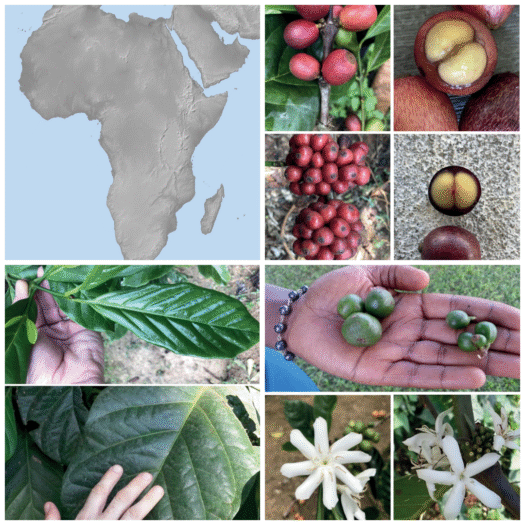Dubai, 12 Ağustos 2025, (Qahwa World) - Nature Plants (DOI: 10.1038/s41477-025-02073-y) dergisinde yayınlanan önemli bir çalışma, kahve dünyasının genetik haritasını yeniden çizdi.
A.P. Davis liderliğindeki araştırmacılar, yüksek çözünürlüklü genomik, morfolojik ve ekolojik analizler yoluyla, uzun süredir tek bir tür olarak kabul edilen Coffea liberica'nın aslında üç farklı tür olduğunu doğruladı:
-
C. liberica (Liberica)
-
C. dewevrei (Excelsa)
-
C. klainei
Bu cesur yeniden sınıflandırma, bilinen resmi kahve türü sayısını 131'den 133'e çıkararak onlarca yıllık taksonomik belirsizliği sona erdiriyor ve özellikle iklim değişikliği karşısında kahve ıslahı, yetiştiriciliği ve korunması için yeni fırsatlar sunuyor.
From One to Three: How the Split Was Proven
The team sequenced 353 nuclear genes across 55 accessions using the Angiosperms353 target capture kit, and examined 2,240 SNPs, morphology, and geographic distribution.
The results revealed three monophyletic clades, each genetically distinct and occupying its own ecological range:
-
C. liberica (Liberica): Wild in upper West Africa—Sierra Leone, Liberia, Ivory Coast, Ghana, Nigeria.
-
C. dewevrei (Excelsa): Native to Central Africa—Republic of the Congo, Cameroon, DRC, Central African Republic, South Sudan, Uganda.
-
C. klainei: Batı-Orta Afrika-Kamerun, Gabon, Kongo Cumhuriyeti, Cabinda'da endemiktir.
Why This Matters for Farmers
Though Liberica and Excelsa together make up less than 0.01% of global coffee exports (under 1,000 tonnes in 2024), production is being upscaled in Uganda, South Sudan, India, Vietnam, Malaysia, the Philippines, Indonesia, and even the Pacific.
The two cultivated species offer complementary advantages:
C. dewevrei (Excelsa)
-
Higher yield, more flowers per node.
-
Smaller, Arabica-like seeds (9.3 × 6.6 mm) with thinner pulp and parchment—better outturn and compatibility with existing Arabica/Robusta post-harvest systems.
-
Grows at 500–1,200 m, cooler climates (22–25 °C), lower rainfall (1,500–1,800 mm).
-
Notable drought tolerance, making it a candidate to replace robusta in warming climates.
C. liberica (Liberica)
-
Larger seeds (12.6 × 8.4 mm), distinct flavor profiles for niche markets.
-
Thrives at 10–500 m, hotter climates (24–27 °C), high rainfall (2,000–4,000 mm), and more seasonal precipitation.
-
Historically valued for leaf rust resistance and adaptation to lowland tropics.
The study also suggests hybrid potential between Liberica and Excelsa—offering breeders the chance to combine Excelsa’s yield with Liberica’s resilience.
Morphology and Climate Niches
The paper’s Table 1 shows clear physical distinctions:
-
Excelsa: Longer, broader leaves; smaller fruits; thinner pulp (0.31 mm parchment vs 0.57 mm in Liberica).
-
Klainei: Morfolojik olarak Liberica'ya daha yakındır ancak sapsız, dallanmamış çiçek salkımları ve dar elipsoid meyveleri vardır.
Climatically, Liberica’s tolerance for seasonal rainfall suits regions with pronounced wet/dry cycles, while Excelsa thrives in more consistent rainfall zones, often riverine or gallery forests.
A Conservation Wake-Up Call
The refined species ranges reveal a much smaller natural footprint:
-
C. liberica’s Extent of Occurrence (EOO) drops from 6.8 million km² to 352,310 km² (−94.8%).
-
Area of Occupancy (AOO): now just 52 km².
This could move Liberica from “Least Concern” to Vulnerable under IUCN criteria.
C. klainei also faces habitat loss; C. dewevrei is less threatened but still impacted by deforestation.
Wild populations hold irreplaceable genetic diversity essential for climate-resilient breeding—losing them could weaken the coffee sector’s future adaptability.
The Bigger Picture for the Coffee Industry
By clarifying where Liberica ends and Excelsa begins, the study equips:
-
Breeders with accurate genetic boundaries to target traits.
-
Farmers with species better matched to their climate and elevation.
-
Conservationists with precise maps to protect threatened wild populations.
As Arabica and Robusta face climate stress, these redefined Liberica species could anchor a more diverse and resilient coffee supply—if the industry acts now to invest in breeding, cultivation trials, and habitat conservation.
Reference: Davis, A.P. et al. (2025). Genomic data define species delimitation in Liberica coffee with implications for crop development and conservation. Nature Plants. DOI: 10.1038/s41477-025-02073-y.
The post Liberica Coffee Reimagined: Three New Species Could Transform Farming and Conservation appeared first on Qahwa World.




